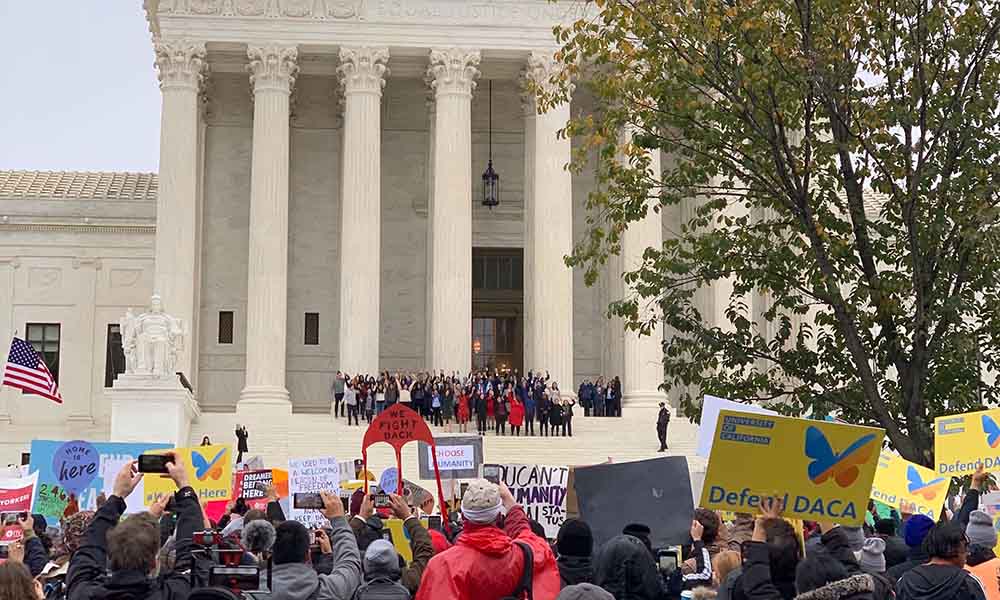Stakes Are Huge for Hundreds of Thousands and Their Communities after Today’s Supreme Court Argument
THE TORCH: CONTENTSBy Trudy Rebert
NOVEMBER 12, 2019
Departing the U.S. Supreme Court into a cold fall day, dozens of people whose lives are in the balance — plaintiffs, their mothers, and other Deferred Action for Childhood Arrivals (DACA) recipients — emerged from today’s oral argument with their arms linked and raised. There, at the top of the long bank of marble steps, they paused before a sea of young people below who were waving signs and cheering to welcome them out of the courthouse. Their departure from the courthouse today was a reminder of the organizing, courage, and fight for inclusion that led to the creation of DACA in 2012, as well as of what’s at stake before the nine justices inside the courthouse.

DACA recipients and others who attended oral argument are greeted by friends and supporters on the Supreme Court’s steps.
Formally, today’s argument addressed two legal questions: (1) whether courts can even review the government’s decision to terminate DACA, a policy that had been in place since 2012, and (2) whether the Trump administration engaged in reasoned decision-making when it decided to terminate DACA (in nonlawyer terms, whether the administration properly “showed its work” or, instead, ended DACA arbitrarily).
But in practical terms, the daily lives of close to 700,000 young people — teachers, parents, medical professionals, neighbors — and the health and welfare of the communities they call home are at stake. Individuals like our plaintiffs Eliana Fernández, a community organizer with Make the Road New York who lives on Long Island with her two U.S. citizen children, and Martín Batalla Vidal, who lives in Queens, New York, and is finishing his college degree while working as a certified nursing assistant caring for people with traumatic brain injuries. Eliana and Martín, along with the plaintiffs in the eight other lawsuits currently before the Court, challenged the administration’s termination of DACA in September 2017.
DACA, first announced in 2012, has allowed hundreds of thousands of young people who grew up and went to school in the U.S. — who are integral members of their many communities — to come forward, declare themselves to the government, and in return receive work authorization and a measure of protection from deportation. DACA is consistent with a long history of deferred action programs enacted by administrations of both parties dating back to the Eisenhower era.
The vast majority of Americans support DACA recipients and their place in our national community. A recent poll showed that 83 percent approve of allowing DACA recipients to become U.S. citizens, meaning that Americans agree more about DACA recipients than just about anything else. This was also evident in the huge outpouring of supporting briefs filed with the Court before today’s hearing, including support from national security experts, many large corporations, medical schools, the Catholic Church, law enforcement, and more. As Justice Stephen Breyer noted from the bench today, 66 medical associations, 210 educational institutions, 3 home builders, 109 municipalities and cities,129 religious organizations, 145 businesses — and more — identified countless different reliance interests in DACA.
The lawyers presented detailed legal arguments about reviewability and the Administrative Procedure Act today, but what it comes down to is quite simple: The Court is also being asked to decide what government accountability means in our democracy. Should the government be able to hide behind legal reasons for ending DACA to avoid having to face the political consequences of ending a popular policy — even if the legal reasons it relies on are unexplained and directly conflict with an existing legal opinion by the Office of Legal Counsel? As Justice Sotomayor noted, “[T]his is not about the law; this is about [the] choice to destroy lives.”
Prior to the Trump administration’s termination of DACA, the president assured the public that DACA recipients would be treated with “great heart,” yet after receiving a letter from the attorney general on September 4, 2017, the then–acting secretary of the U.S. Department of Homeland Security (DHS) abruptly ended the program, writing that she had no choice but to end DACA because it is unlawful.
But through documents obtained as a result of Freedom of Information Act (FOIA) litigation that the National Immigration Law Center filed on behalf of Make the Road New York and Make the Road Connecticut, we know that the decision to terminate DACA was actually made at a meeting in the White House on August 24, 2017. There the administration hatched a plan to have the U.S. Department of Justice send DHS a letter “outlining the legal reasons that the DACA program is unlawful,” for DHS to draft a memorandum to terminate DACA, and for the administration to develop a list of legislative items that the president would trade to protect DACA recipients. Even Newt Gingrich warned that such a strategy risked sending a signal that the administration was dehumanizing DACA recipients as a “bargaining chip.” The Trump administration also reportedly considered terminating DACA by having the president issue an executive order, but abandoned that path.
DACA recipients around the country hope that the Supreme Court will see through the administration’s unreasoned decision-making and attempts to shirk responsibility for an unpopular political decision. Their lives and families depend on it. We have strong arguments that court after court have agreed with, U.S. district courts from California to New York to Maryland to DC. But whatever happens when the Court issues its opinion sometime between January and June, we will continue fighting alongside immigrant youth as they courageously lead the immigrant justice movement, fighting for inclusion and recognition and for the future of our country.
Trudy Rebert is a NILC staff attorney.





